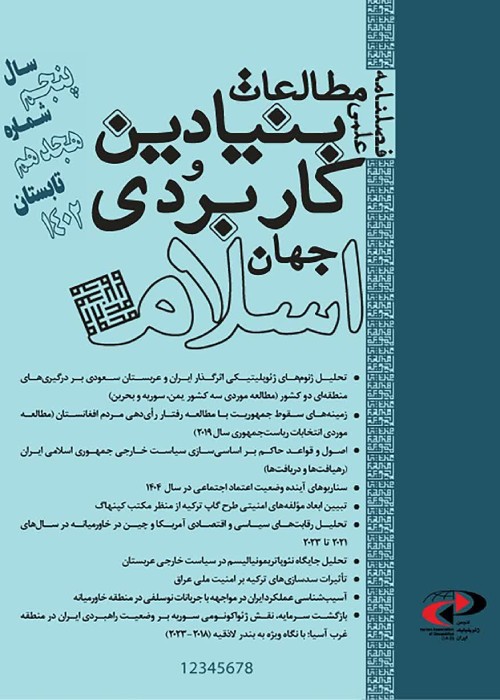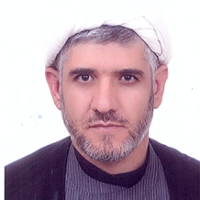Characteristics, elements and components of Salafi fundamentalists in Eastern Iran
The word fundamentalism is usually associated with the meaning of traditionalism and contrary to the discourse of modernity, and in the sense of returning to the original principles and the great era of the past, referring to the text of the book and tradition. Salafism is one of the contemporary sects, sometimes referred to as Islamic fundamentalists. Contemporary Salafi fundamentalists are divided into three sects: the Salafi fundamentalists of Africa, the Salafi fundamentalists of the Hejaz and Yemen, and the Salafi fundamentalists of the Indian subcontinent. Among these, the Salafis of the Indian subcontinent are the least known. They are parts of the subcontinent Salafis in the eastern neighborhood of Iran, whose deep knowledge is more necessary from a security and cultural point of view, especially in the current situation with the Taliban. Our aim in this study is to provide a definition of fundamentalism and explain the main elements of Salafi fundamentalism in eastern Iran. The research method is descriptive-analytical. The results show that contemporary Salafi fundamentalists are not a uniform movement with common beliefs. These movements have potentials that, depending on their interactions with others, can be an opportunity or a threat. Some of these characteristics and positive aspects of Eastern fundamentalists are their view of the global arrogance of the United States and Israel, as well as their Sufi and mystical tendencies. Resistance to modern culture and modernity and their anti-Westernism are other distinguishing features of the fundamentalists of Afghanistan and Pakistan. The tendency towards Abu Hanifa and Abu Mansour al-Matridi has created an opportunity for rational dialogue and the acceptance of international rational rules among them. The Salafi current, with all its branches and differences, has been and is a living, dynamic and influential current in the Islamic society. however, the subcontinent Salafist current has a different place. Despite its history, breadth and antiquity, and the dependence of a large population on it in the eastern part of the Islamic world, it has not been given the attention it deserves. Most studies have focused on the Salafi currents in Egypt and the Hejaz. Perhaps the unfamiliarity of researchers with languages such as Urdu, Pashtun and Hindu and the non-translation of these works into Persian, Arabic and English are the reasons for this lack of attention. The Indian subcontinent is one of the demographic and ideological poles of the Islamic world. The Indian subcontinent, like Egypt, has long been the center of change and the origin of reformist or extremist ideas. The political, social and religious condition of the subcontinent, in general and Pakistan in particular, has become a source of conflict between Islamic religions after the division of the subcontinent with the intervention of the Hejazi Wahhabis, so much so that extremist Wahhabi Salafis consider this region their paradise. Wahhabis have made takfir a common practice in the region. Such an atmosphere has been exploited most of all by Saudi extremist Salafism, which makes good use of it by trying to converge the existing Salafi movements in the region. The need for a deep understanding of contemporary Salafis, especially sub-continental Salafis, the need to pay attention to the ideological and theoretical issues of the Middle Eastern people, which in turn leads to political and military issues and actions, the need for inter-sectarian and inter-religious issues, and opposition to the Shiites and the re-emergence of fundamentalists such as the Taliban in eastern Iran, as well as the need to recognize them, are factors that have led to the focus on this issue for research. Iran's several thousand kilometers of neighborhood with these fundamentalists doubles the need for the issue. Numerous articles have been written about the Salafi movement and Wahhabism and the term fundamentalism, but in our search we did not find any research that addressed the issues and elements of Salafi fundamentalists in eastern Iran, so from this point of view the subject of this study is a research gap has it. We chose "fundamentalism" as one of the salient features of this type of movement in order to study it in depth. Hence, the question arises as to what are the elements and elements of the fundamentalism of the Salafis of eastern Iran? We conducted this research by documentary-analytical method. To answer the research question, we first explain the concept of Salafi fundamentalism in Eastern Iran and in the next stage, the main elements and characters of the fundamentalists in Eastern Iran. The results of this study show that current Salafi fundamentalists can be divided into Wahhabi and Najdi fundamentalists, Yemeni fundamentalists, Syrian and Iraqi fundamentalists, Egyptian fundamentalists, and subcontinental and oriental fundamentalists. Contemporary Salafi fundamentalism is not a uniform movement with common beliefs. Their internal differences are such that they have repeatedly confronted each other and excommunicated and massacred each other. Eastern fundamentalists benefit from aspects that, by focusing and highlighting them, make it possible to take advantage of capacity and opportunity in international and cultural interactions. Some of these characteristics and positive aspects of the Eastern fundamentalists are their view of the global arrogance of the United States and Israel, as well as their resistance to modern culture and modernity and their anti-Westernism are other distinguishing features of the fundamentalists of Afghanistan and Pakistan. Having mystical and mystical tendencies is another of their characteristics. The tendency towards Abu Hanifa and Abu Mansour al-Matridi has created an opportunity for rational dialogue and the acceptance of international rational rules among them.
- حق عضویت دریافتی صرف حمایت از نشریات عضو و نگهداری، تکمیل و توسعه مگیران میشود.
- پرداخت حق اشتراک و دانلود مقالات اجازه بازنشر آن در سایر رسانههای چاپی و دیجیتال را به کاربر نمیدهد.



